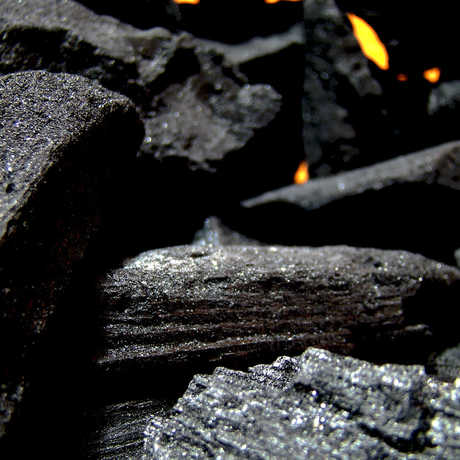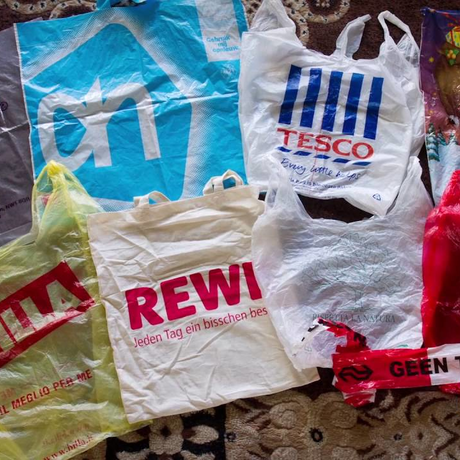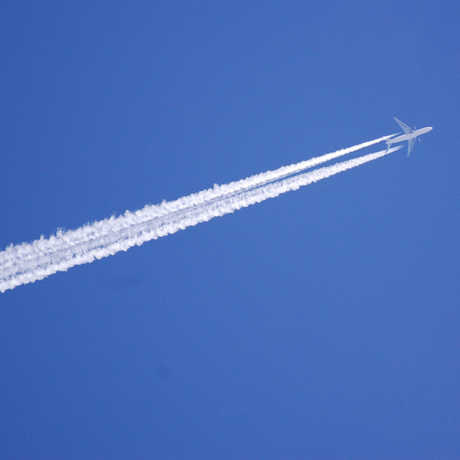
"Nuclear Power Plant Cattenom" © 2005 Stefan Kühn
In these two activities, students will explore two consequences of burning fossil fuels: air pollution and the greenhouse effect. For a comprehensive unit on fossil fuels, this lesson works especially well as an extension to Fossil Fuels: Chocolate Chip Mining.
Students will be able to:
- describe at least two problems with burning fossil fuels.
- recommend solutions for reducing use of fossil fuels.
The Greenhouse Effect
- 2 500mL beakers
- 2 Alka-Seltzer tablets
- 2 gooseneck desk lamps with:
- 2 bulbs of the same wattage, 60 watts or above (not CFLs!)
- 2 identical thermometers
- Water
- Modeling clay
- Plastic cling wrap (Glad Press’n Seal works well)
- Greenhouse Effect Data Sheets (1 per student)
- Take Action Surveys (1 per student)
Air Pollution
- Candle (1 if doing a demonstration. 1 per group if older students are participating.)
- Glass jar or beakers (2-3 if doing a demonstration. 1 per group if older students are participating.)
- fossil fuel: an energy-rich substance such as petroleum, coal, or natural gas formed from the remains of organisms
- global warming or climate change: the recent and ongoing rise in global average temperature of Earth’s surface, caused by increasing concentrations of greenhouse gases
- greenhouse gases: gases in Earth’s atmosphere that absorb infrared radiation and trap heat. Some greenhouse gases are naturally occurring compounds (like water vapor, carbon dioxide and methane) while others are human-made (like gases used for aerosols).
- coal: a dark-brown to black solid substance formed naturally from the compaction and hardening of fossilized plants and used as a fuel primarily for electricity generation
- natural gas: a mixture of hydrocarbon gases that occurs naturally beneath the earth’s surface and is used as a fuel primarily for cooking and heating homes
- soot: a black, powdery substance chiefly composed of carbon, produced by incomplete combustion of coal, oil, wood or other materials
- renewable resource: a resource that is never used up (e.g., solar energy)
- non-renewable resource: a resource that is not replaceable after its use (e.g., coal, gas)
This experiment has a tendency to not show intended results if the steps are not followed precisely. For this reason, we recommend doing it once beforehand, without students, to familiarize yourself with the setup and be sure all the pieces are working. If you are not seeing the temperature in Beaker 2 rising faster than that in Beaker 1, try the troubleshooting tips below.
- Thermometers: Are they both calibrated the same? If one thermometer isn’t reading the temperature correctly, this will throw off your data. You can check this by putting both thermometers in the same beaker of warm water. If they don’t read the same temperature, then at least one of them is wrong.
- Heat: If the beakers aren’t getting the same amount of heat from the lamps, this will also change your results. Are the bulbs the same wattage? Are they close enough, and the same distance, to each of the beakers?
- Cling wrap: Make sure you have a tight seal on the top of each beaker, or the CO2 will slowly escape.
- Review terms like fossil fuels, climate change, and air pollution.
- Ask students what they think happens when fossil fuels are burned. Many students know that burning anything will lead to air pollution, so use this as a segue to introduce the concept of greenhouse gases.
- This video from NASA gives a good, student-friendly introduction to greenhouse gases.
- This video from NASA gives a good, student-friendly introduction to greenhouse gases.
- Introduce the model. Beaker 1 will represent the Earth without the additional greenhouse gases. Beaker 2 will represent the Earth with extra carbon dioxide forming an added barrier, keeping more heat in. The Alka-Seltzer tablets will form CO2 gas as they dissolve in the water.
Teacher tip: If your students are not familiar with the concept of a model, go over what this means first. A definition is something that represents an object or process, typically on a smaller scale. In this case, the greenhouse effect that happens on our planet is far too large to see, so we recreate it smaller with visible results to help us understand this process.
Teacher Tip: Make this a group effort by having different students help with each step, including observing and recording temperatures.
- Pass out Greenhouse Effect Data Sheets. Use the modeling clay to attach a thermometer to each beaker. It should be angled with the tip inside but not touching the edge. Make sure each thermometer is the same distance in: approximately 5cm from the beaker edge to the tip of the thermometer is a good distance. (See Figure 1 on page 4)
- Add 200mL of water to each of the beakers.
- Prepare your lamps. Set them up next to each other with the necks angled so they will just fit over the tops of the beakers. Turn them on so they are ready.
- Have students record the starting temperature – it should be the same in both beakers.
- Add both Alka-Seltzer tablets to one of the beakers, and immediately cover both beakers with cling wrap. A tight seal around the edge will work best, and make sure thermometers are left visible so you can record the temperature.
- Slide each beaker under one lamp and turn it to the thermometer is visible. (See Figure 2 on page 4)
- Record the temperature in both beakers every 5 minutes for 45 minutes to an hour or until the temperatures stabilize. At the end, have students answer questions at the bottom of their data sheets. Teacher tip: Do the Candle Pollution demonstration in between recordings.
- Light a candle and let it burn for a few seconds.
- Hold the glass jar or beaker above the flame so that the glass touches the top of the flame.
- After soot has covered most of the surface, set it upside down to cool. Repeat as many times as you want jars to show to students. Teacher Tip: Older students can do this in small groups. Warn students that the glass will get HOT.
- Pass jars around so that students can see (or touch it if they want) the black substance covering the jar.
- Ask students about the substance on the jar. What is it? How is it formed?
- Explain to students what soot is and how it is created. The soot is the buildup of carbon particles from burning a candle. This is a small-scale version of the air pollution resulting from the burning of fossil fuels.
- Review the questions at the bottom of the data sheet with the class:
- What is happening? Why?
- How is this similar to what is happening on Earth?
- What are two problems that are caused by global climate change?
- Discuss with the students:
- What are some of the problems associated with using fossil fuels for energy? (air pollution can harm ecosystems and human health, climate change)
- What are some things that we can do to lessen these problems in our world? (conserve energy, use more efficient technology that consumes less energy, encourage the use of renewable energy sources)
- What are some things students can do in their lives to use less fossil fuels? (unplug electronics, use less water, recycling, wear used clothing)
- Hand out the Take Action Surveys. This survey is designed for families to complete together. Challenge your students to try changing two behaviors by the end of the month.
- For a more comprehensive unit on fossil fuels, pair this activity with Fossil Fuels: Chocolate Chip Mining.
- To learn more about the greenhouse effect, follow up with Global Climate Change and Sea Level Rise and Differing Densities: Fresh and Salt Water.
Fossil Fuels
Fossil fuels like coal, oil, and natural gas present environmental problems starting with their extraction and going all the way through to their use. They are all different in their properties and uses, but they have some similarities. Fossil fuels all come from fossilized plant or animal material and are all nonrenewable resources; they take millions of years to form and do not regenerate on the timescale of a human life. All fossil fuels go through similar processes on their path from being extracted from the ground to serving as fuels for human beings.
We use fossil fuels for most of our energy needs today. Coal, natural gas, and oil accounted for 87 percent of global primary energy consumption in 2012, and they meet 82% of U.S. energy demand (Worldwatch Institute, 2013; Institute for Energy Research, 2014).
Greenhouse Gases
While greenhouse gases have received a lot of negative attention lately, it is also necessary to understand their importance. The earth has a layer of naturally occurring gases around the planet, including carbon dioxide (CO2), methane (CH4), and nitrous oxide (N2O) (EPA 2015). Much like a greenhouse for plants, these gases trap the sun’s heat around our planet making it warm enough to survive – indeed, we would not survive without them.
However, as fossil fuels burn, they release more greenhouse gases into the atmosphere. They absorb energy, slowing or preventing the loss of heat to space. In this way, they act like a blanket, making Earth warmer than it would otherwise be. Most of the observed global warming since the mid-20th century is due to human-caused greenhouse gas emissions (USEPA, 2014).
Some of the potential effects of global climate change will be an increase in wildfires, longer periods of drought, and an increase in the duration and intensity of tropical storms. The rising temperature will also cause a rise in sea level due to the melting of glacial ice, which in turn will cause flooding in coastal areas. (NASA, 2014).
Air Pollution
Air pollutants are those substances added to the air by humans that have negative environmental and health consequences. Air pollutants include particulates (particles of solids in the air), sulfur oxides, nitrogen oxides, hydrocarbons, carbon monoxide, and more.
Each year in the United States, industrial operations emit nearly 100 million tons of pollutants into the air. These include pollutants that make breathing difficult, form urban smog, impair visibility, and attack ecosystems. Air pollutants result in both environmental problems like acid rain and human health concerns like emphysema, bronchitis, and asthma (USEPA, 2011).
For up to date Air Quality information, go to Airnow, a cross-agency U.S. Government Web site.
Energy Conservation
As global supplies of cheap fossil fuels steadily decline and fossil fuel related greenhouse gases accumulate in the atmosphere, energy conservation is becoming a critical topic of discussion. Climate change is an important reason for people to reduce their fossil fuel consumption via conservation, efficiency measures, and switching to renewable energy sources.
Some of these technologies include: wind energy, biomass energy, carbon capture and underground storage, methane capture and use, geothermal energy, energy-efficient buildings and solar energy. These technologies are explained in detail here.
Science and Engineering Practices
- Developing and Using Models: Develop and/or use models to describe and/or predict phenomena.
- Constructing Explanations and Designing Solutions: Use evidence to construct or support an explanation or design a solution to a problem.
Disciplinary Core Ideas
- 4-ESS3A: Energy and fuels that humans use are derived from natural sources, and their use affects the environment in multiple ways. Some resources are renewable over time, and others are not.
- 5-ESS3C: Human activities in agriculture, industry and everyday life have had major effects on land, vegetation, streams, oceans, air and even outer space.
- MS-ESS3A: Minerals, fresh water, and biosphere resources are limited, and many are not renewable or replaceable over human lifetimes.
- MS-ESS3C: Human activities have significantly altered the biosphere, sometimes damaging or destroying natural habitats and causing the extinction of other species.
- MS-ESS3C: Typically as human populations and per-capita consumption of natural resources increase, so do the negative impacts on Earth, unless the activities and technologies involved are engineered otherwise.
Cross-Cutting Concepts
- Cause and Effect: Cause and effect relationship may be used to predict phenomena in natural or designed systems.
- Systems and System Models: Models are limited in that they only represent certain aspects of the system under study.
- Stability and Change: Stability might be disturbed either by sudden events or gradual changes that accumulate over time.
Related Performance Expectations
- 4-ESS3-1: Obtain and combine information to describe that energy and fuels are derived from natural resources and that their uses affect the environment.
- MS-ESS3-4: Construct an argument supported by evidence for how increases in human population and per-capita consumption of natural resources impact Earth’s systems.
- AirNow. Accessed May 7, 2015.
- Air Pollution Operating Permit Program Update: Key Features and Benefits. (n.d.) Retrieved on October 8, 2014.
- Causes of Climate Change. (n.d.). Retrieved on October 8, 2014.
- Gonzalez, M., & Lucky, M. (2013). Fossil Fuels Dominate Primary Energy Consumption.
- NASA's Earth Minute: Gas Problem. Accessed on May 7, 2015.
- Overview of Greenhouse Gases. Accessed on May 7, 2015.
- Technologies. (2014). Retrieved on November 19, 2014.
- The Current and Future Consequences of Global Chance. (n.d.) Retrieved on November 19,m 2014.
- Image: "Nuclear Power Plant Cattenom" by Stefan Kühn, licensed and modified under CC BY-SA; originally sourced from https://commons.wikimedia.org/wiki/File:Nuclear_Power_Plant_Cattenom.jpg


